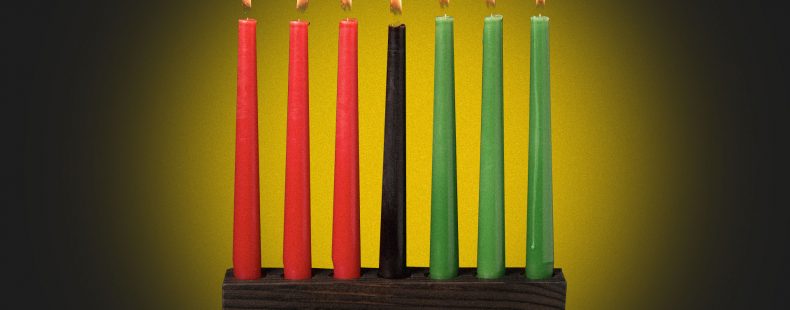The holiday season is a time to give thanks, connect with loved ones, and think ahead to the future. For those who celebrate Kwanzaa, this festive season ends and the new year begins with a celebration of pan-African culture and history. Observers light candles, commemorate key principles and ideals, and spend time with friends and family from December 26 until January 1.
Look no further if you’re getting ready for your first Kwanzaa celebration, or if you simply need to brush up on some of the holiday’s terminology. From the origin of the holiday’s name to the seven principles and symbols, this is the language you need to know to understand Kwanzaa.
What is Kwanzaa?
Kwanzaa is a relatively new holiday. African-American scholar, professor, and activist Maulana Karenga created Kwanzaa in the 1960s when he was 25 years old. In doing so, he combined elements from various African harvest celebrations to highlight the values and strength of the African-American community, like the struggle for self-determination, equality, and justice. In a 2008 newspaper interview, Karenga said he created the holiday to “give Blacks an opportunity to celebrate themselves and their history.”
Kwanzaa is a celebration of African heritage and Black culture, and it’s also meant to be a counter to holidays that center mainstream culture and consumerism. Though it’s most commonly observed in the United States, people in the African diaspora celebrate Kwanzaa in other parts of the world, too. According to a 2012 study, approximately 4 percent of Americans reported celebrating Kwanzaa—which would represent more than 12.5 million people.
The name for this holiday originally comes from the Swahili word kwanza, which translates to “first, firstly,” and is a reference to the Swahili saying matunda ya kwanza, or “first fruits of the harvest.” Karenga used African harvest celebrations to create Kwanzaa because the communal aspects that lead to a successful harvest are also aspects that build and maintain strong communities.
Kwanzaa, the holiday, has an extra -a tacked onto the end of the original Swahili word. It’s believed that the extra letter was added so that each of the seven children participating in the first Kwanzaa gatherings in 1966 could have a letter. The number is fitting, considering that seven holds an especially important place in Kwanzaa celebrations, and the number runs through many aspects of the holiday. There are seven days of Kwanzaa, seven symbols, seven candles in the rituals (more on that later), and seven key principles focused on family and community.
How Kwanzaa is observed
Kwanzaa is part of the holiday season in the US along with Thanksgiving, Hanukkah, Christmas, and New Year’s Eve. It’s a secular holiday, and therefore is not affiliated with any major organized religion. In fact, those who celebrate Kwanzaa often also celebrate one or more of the other holidays during the season.
⚡️The seven principles of Kwanzaa
The seven-day holiday is defined by the seven principles (or Nguzu Saba) of Kwanzaa, which are typically referenced by their Swahili word. Each principle has a day devoted to it and to discussion about what it represents. The seven principles are:
- Umoja (unity)
- Kujichagulia (self-determination)
- Ujima (collective work and responsibility)
- Ujamaa (cooperative economics)
- Nia (purpose)
- Kuumba (creativity)
- Imani (faith)
People greet each other on each of the seven days of Kwanzaa with the Swahili way to ask “What is the news?”: habari gani. The expected response is the principle of the day (for example, “Umoja” on the first day).
The specifics of how each family celebrates Kwanzaa vary, but family gatherings, music, and storytelling are typical. The seven symbols are another commonality. The primary symbol is the set of seven candles (mishumaa saba) that plays a central role throughout the holiday. The three green candles, one black candle, and three red candles are placed in a kinara, or candle holder. Ears of corn (muhindi), gifts (zawadi), a mat (mkeka), crops (mazao), and a ceremonial unity cup called kikombe cha umoja are other important symbols.
The second-to-last day of Kwanzaa is New Year’s Eve. It’s called karamu, and people rejoice with food, drinks, and music. On either karamu or the final day of Kwanzaa, imani, kids open their gifts, called zawadi, that are either handmade or purchased from Black-owned businesses.
Another New Year’s Eve tradition is singing Auld Lang Syne. Learn the meaning of this song here.
What’s the significance of the candles on Kwanzaa?
One of the most important Kwanzaa rituals revolves around the candles. The black candle is always in the center, while the red candles are on the left and the green on the right. Marcus Garvey listed these colors as representative of the people of the African diaspora, where red represents the struggle, black the people, and green the future.
On each day before lighting, the entire family gathers and starts the ritual with tambiko, which is an African form of praise to their ancestors. The house elder pours a drink (either alcoholic or non-alcoholic) from the unity cup (kikombe cha umoja), and says a remembrance for friends and family who have died. Then, they drink juice, wine, or spirits from the kikombe cha umoja and pass it to others to do the same.
The candle lighting is also a time for the family to discuss the meaning of the principle of the day. The black candle is lit on the first day, December 26, and then the remaining candles are lit in an alternating left to right pattern each day until the end of Kwanzaa on January 1.












